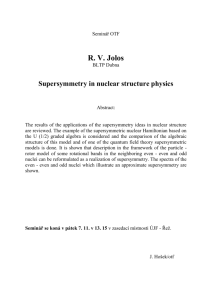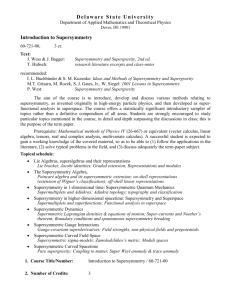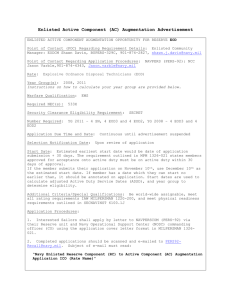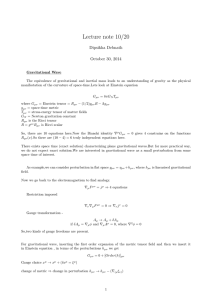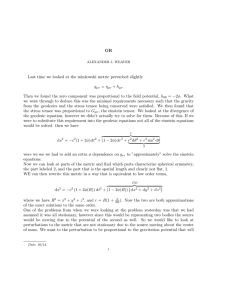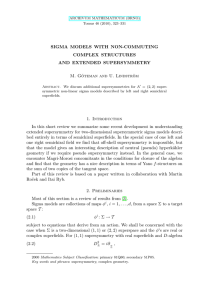Emergent Supersymmetry in Warped Backgrounds
advertisement
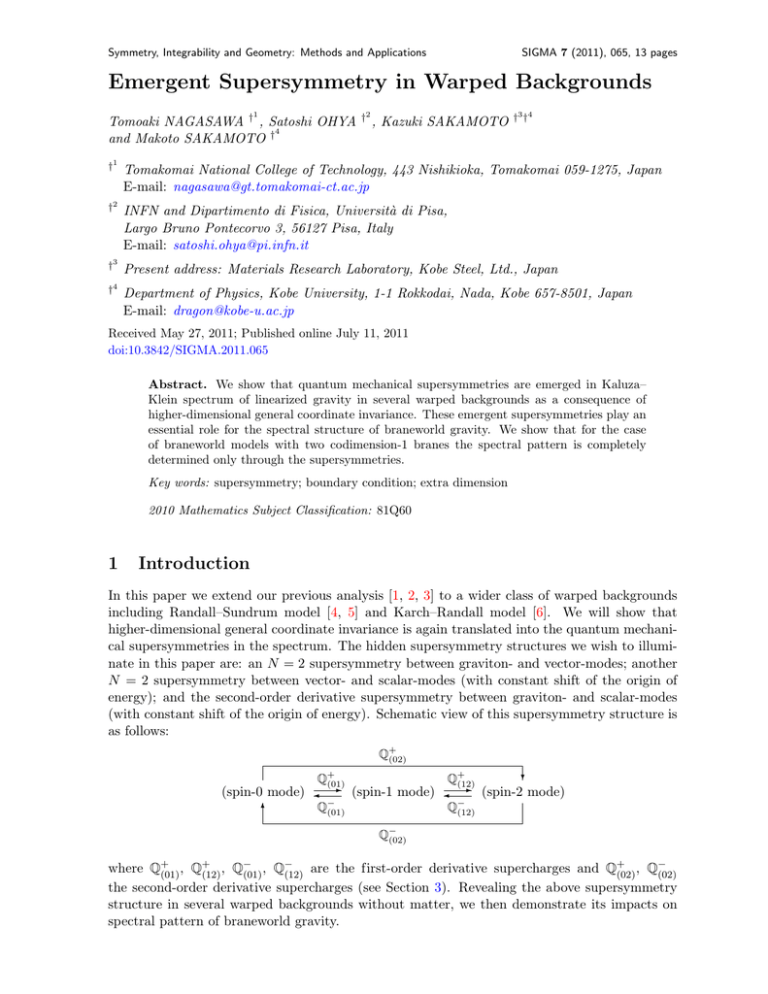
Symmetry, Integrability and Geometry: Methods and Applications
SIGMA 7 (2011), 065, 13 pages
Emergent Supersymmetry in Warped Backgrounds
1
Tomoaki NAGASAWA † , Satoshi OHYA
4
and Makoto SAKAMOTO †
†2 ,
Kazuki SAKAMOTO
†3 †4
†1
Tomakomai National College of Technology, 443 Nishikioka, Tomakomai 059-1275, Japan
E-mail: nagasawa@gt.tomakomai-ct.ac.jp
†2
INFN and Dipartimento di Fisica, Università di Pisa,
Largo Bruno Pontecorvo 3, 56127 Pisa, Italy
E-mail: satoshi.ohya@pi.infn.it
†3
Present address: Materials Research Laboratory, Kobe Steel, Ltd., Japan
†
4
Department of Physics, Kobe University, 1-1 Rokkodai, Nada, Kobe 657-8501, Japan
E-mail: dragon@kobe-u.ac.jp
Received May 27, 2011; Published online July 11, 2011
doi:10.3842/SIGMA.2011.065
Abstract. We show that quantum mechanical supersymmetries are emerged in Kaluza–
Klein spectrum of linearized gravity in several warped backgrounds as a consequence of
higher-dimensional general coordinate invariance. These emergent supersymmetries play an
essential role for the spectral structure of braneworld gravity. We show that for the case
of braneworld models with two codimension-1 branes the spectral pattern is completely
determined only through the supersymmetries.
Key words: supersymmetry; boundary condition; extra dimension
2010 Mathematics Subject Classification: 81Q60
1
Introduction
In this paper we extend our previous analysis [1, 2, 3] to a wider class of warped backgrounds
including Randall–Sundrum model [4, 5] and Karch–Randall model [6]. We will show that
higher-dimensional general coordinate invariance is again translated into the quantum mechanical supersymmetries in the spectrum. The hidden supersymmetry structures we wish to illuminate in this paper are: an N = 2 supersymmetry between graviton- and vector-modes; another
N = 2 supersymmetry between vector- and scalar-modes (with constant shift of the origin of
energy); and the second-order derivative supersymmetry between graviton- and scalar-modes
(with constant shift of the origin of energy). Schematic view of this supersymmetry structure is
as follows:
Q+
(02)
?
Q+
Q+
(01)
(12)
(spin-0 mode) (spin-1 mode) - (spin-2 mode)
Q−
Q−
(01)
(12)
6
Q−
(02)
+
−
−
+
−
where Q+
(01) , Q(12) , Q(01) , Q(12) are the first-order derivative supercharges and Q(02) , Q(02)
the second-order derivative supercharges (see Section 3). Revealing the above supersymmetry
structure in several warped backgrounds without matter, we then demonstrate its impacts on
spectral pattern of braneworld gravity.
2
T. Nagasawa, S. Ohya, K. Sakamoto and M. Sakamoto
The rest of this paper is organized as follows. Section 2 is devoted to a quick review for the
background warped geometries we use. In Section 3 we show that quantum mechanical supersymmetries generically emerge in the Kaluza–Klein mass eigenvalue problems as a consequence
of higher-dimensional general coordinate invariance. In Section 4 we show that in braneworld
gravity with two codimension-1 branes the spectral pattern of Kaluza–Klein modes is completely
determined only through the supersymmetry structure. We conclude in Section 5.
2
Preliminary: background geometry
In this paper we study linearized pure Einstein gravity on (d + 1)-dimensional warped backgrounds described by the following metric
ds2 = GM N (x, z)dxM dxN = e2A(z) gµν (x)dxµ dxν + dz 2 ,
(1)
where A(z) is the warp factor which turns out to play a role of superpotential (or prepotential) in
analog supersymmetric quantum mechanics. In this section we recall the background geometries
given as the classical solutions to the Einstein equation without matter with respect to the
metric (1). (Throughout of this paper the spacetime dimension (d + 1) is left arbitrary although
in the phenomenological viewpoint we are interested in the case d = 4.)
To begin with, let us start with the action. The bulk Einstein–Hilbert action that describes
braneworld we wish to study is
Z
Z
√
d−1
d
SEH = M
d x dz −G R(G) − d(d − 1)Λd+1 ,
where M is the mass scale of (d + 1)-dimensional gravity and Λd+1 is the (d + 1)-dimensional
bulk cosmological constant. The factor d(d − 1) is introduced for later convenience. R(G) is
the Ricci scalar curvature constructed from the background metric GM N . The integration range
of z will be specified later. (Our conventions for the curvature tensor, Ricci tensor etc. are
summarized in Appendix A.)
As shown in Appendix A, the bulk Einstein equations are reduced to the following nonlinear
equations for the warp factor:
[A0 (z)]2 − A00 (z) = Λd ,
(2)
A00 (z)e−2A(z) = −Λd+1 ,
(3)
where prime (0 ) indicates the derivative with respect to z. Λd is the cosmological constant for
the d-dimensional foliation of the bulk spacetime given by
R(g) = d(d − 1)Λd ,
where R(g) is the Ricci scalar constructed from the metric gµν (x). We note that the differential
equation (2) is nothing but the Riccati equation such that it can be linearized as (−∂z2 +
Λd )e−A(z) = 0. Thus, according to the sign of the cosmological constants Λd+1 and Λd , we
obtain the following four types of the warp factors [6]:
`d
z − z0
− log
sin
for Λd < 0 and Λd+1 < 0 (AdSd /AdSd+1 ),
`d+1
`d
z − z0
for Λd = 0 and Λd+1 < 0 (Md /AdSd+1 ),
− log `
d+1
A(z) =
(4)
`d
z − z0
− log
sinh
for Λd > 0 and Λd+1 < 0 (dSd /AdSd+1 ),
`d+1
`d
`d
z − z0
− log
cosh
for Λd > 0 and Λd+1 > 0 (dSd /dSd+1 ),
`d+1
`d
Emergent Supersymmetry in Warped Backgrounds
3
where z0 is the integration constant. `d+1 and `d are the curvature scale of bulk spacetime and
its foliation, respectively, and given by
1
`d+1 := p
≥ 0,
|Λd+1 |
1
`d := p
≥ 0.
|Λd |
Now we are in a position to specify the range of coordinate z. First, without any loss of
generality we can set z0 = 0 because it just corresponds to the choice of the origin. Then,
according to the configuration of codimension-1 brane(s), the range of z should be chosen as
follows:
• Two zero-thickness branes:
(z1 , z2 ), 0 < z1 < z2 < π`d ,
(z , z ), 0 < z < z < ∞,
1 2
1
2
z∈
(z1 , z2 ), 0 < z1 < z2 < ∞,
(z , z ), −∞ < z < z < ∞,
1 2
1
2
• A single zero-thickness brane:
(z1 , π`d ), 0 < z1 < π`d ,
(z , ∞), 0 < z < ∞,
1
1
z∈
(z1 , ∞), 0 < z1 < ∞,
(z , ∞), −∞ < z < ∞,
1
1
• Without zero-thickness
(0, π`d ),
(0, ∞),
z∈
(0, ∞),
(−∞, ∞),
for
for
for
for
for
for
for
for
AdSd /AdSd+1 ,
Md /AdSd+1 (Randall–Sundrum I [4]),
(5)
dSd /AdSd+1 ,
dSd /dSd+1 .
AdSd /AdSd+1 (Karch–Randall [6]),
Md /AdSd+1 (Randall–Sundrum II [5]),
dSd /AdSd+1 (Karch–Randall [6]),
dSd /dSd+1 .
brane:
for
for
for
for
pure
pure
pure
pure
AdSd /AdSd+1 ,
Md /AdSd+1 ,
dSd /AdSd+1 ,
dSd /dSd+1 .
Each brane configuration has its own advantage such as a candidate to the solution of hierarchy problem [4] or alternative scenario to compactification as a consequence of localization of
massless graviton mode at the brane position [5, 6]. Irrespective of these brane configurations,
there always exists supersymmetry structure in the spectrum of dimensional reduced theory. For
the sake of simplicity, however, in what follows we will concentrate ourselves to the case of two
branes configuration (5) in order to discretize the spectrum. The case of pure AdSd /AdSd+1 is
briefly discussed in Appendix B.
3
From general coordinate invariance
to quantum mechanical supersymmetry
Supersymmetry structure in braneworld gravity has been already pointed out by several authors
and used to analyze the Kaluza–Klein spectrum [7, 8, 9]. However, all of these analysis are just
based on one of two N = 2 supersymmetries between graviton- and vector-modes. Whole
supersymmetry structure has not yet been uncovered. In this section we show that quantum
mechanical supersymmetries generically emerge as a consequence of (d + 1)-dimensional general
coordinate invariance.
4
T. Nagasawa, S. Ohya, K. Sakamoto and M. Sakamoto
To begin with, let us consider metric fluctuations hM N around the background metric (1) as
follows
ds2 = e2A(z) [gM N (x) + hM N (x, z)] dxM dxN .
The most useful parameterization of hM N is turned out to be of the form
1
hµν − d−2
gµν φ hµz
hM N =
.
hzν
φ
Under the infinitesimal coordinate transformation xM 7→ x̂M = xM + ξ M (x, z), the metric
fluctuations transform, at the linearized level, as hM N (x, z) 7→ ĥM N (x, z) = hM N (x, z) +
δhM N (x, z), where
δhµν = −∇µ ξν − ∇ν ξµ −
2
gµν ∂z + (d − 1)A0 ξz ,
d−2
δhµz = −∂z ξµ − ∇µ ξz ,
δφ = −2 ∂z + A0 ξz .
(6)
(7)
(8)
Here ∇µ is the covariant derivative with respect to the background metric gµν (x). As we will
show below, the linearized general coordinate transformations (6)–(8) are translated into the
supersymmetry transformations on the mode functions.
To see this, let us first suppose that the metric fluctuations are expanded into some complete
(n)
(n)
(n)
orthogonal basis {f0 (z)}, {f1 (z)} and {f2 (z)}, which are determined later, and written as
follows
X
(n)
hµν (x, z) =
h(n)
(9)
µν (x)f2 (z),
n
hµz (x, z) =
X
(n)
h(n)
µz (x)f1 (z),
(10)
n
φ(x, z) =
X
(n)
φ(n) (x)f0 (z).
(11)
n
If one wants to study braneworld models with non-compact extra dimension, contributions from
the continuum spectrum must be added. The supersymmetry structure we wish to show below
is, however, independent of whether the spectrum is discrete or continuum.
Now let us move on to the analysis of supersymmetry structure between vector- and gravitonmodes. Since the covariant derivative ∇µ is blind for the coordinate z, the first two terms of
the gauge transformation (6) implies that the gauge parameter ξµ (x, z) should be expanded by
P (n)
(n)
the same basis to hµν such that it should be written as ξµ (x, z) = n ξµ (x)f2 (z). Then,
(n)
in order to be consistent with the first term of the gauge transformation (7), ∂z f2 must be
(n)
proportional to f1 . Thus we are led to the following relation:
(n)
(n)
A−
1 f2 (z) = mn f1 (z)
with A−
1 := ∂z ,
(12)
where mn is just a proportional coefficient here.
Next, according to the second term of the gauge transformation (7), we see that the gauge
parameter ξz (x, z) should be expanded by the same basis to hµz such that it must be written as
P (n)
(n)
ξz (x, z) = n ξz (x)f1 (z). Then, according to the last term of the gauge transformation (6),
(n)
(n)
we conclude that −(∂z + (d − 1)A0 )f1 must be proportional to f2 :
(n)
(n)
A+
1 f1 (z) = mn f2 (z)
0
with A+
1 := − ∂z + (d − 1)A ,
(13)
Emergent Supersymmetry in Warped Backgrounds
5
where we have used the fact that without any loss of generality we can use the same coefficient
as (12). These two equations lead to the following eigenvalue equations
(n)
(n)
+
0
H1 f1 (z) = m2n f1 (z)
with H1 := A−
(14)
1 A1 = −∂z ∂z + (d − 1)A ,
(n)
(n)
−
0
H2 f2 (z) = m2n f2 (z)
with H2 := A+
(15)
1 A1 = − ∂z + (d − 1)A ∂z .
−
As we will show in the next section, A+
1 and A1 are hermitian conjugate to each other. Now it
is obvious that there exists an N = 2 quantum mechanical supersymmetry structure. Indeed,
by introducing the following operators
− +
H1 0
A1 A1
0
0 0
0 A−
+
−
1
H(12) =
=
Q(12) =
,
Q(12) =
,
− ,
0 H2
0
A+
A+
0
0 0
1 A1
1
which act on the two-component vector (f1 (z), f2 (z))T (where T stands for transposition), we
have the N = 2 supersymmetry algebra
−
{Q+
(12) , Q(12) } = H(12) ,
+
−
−
{Q+
(12) , Q(12) } = {Q(12) , Q(12) } = 0,
−
[H(12) , Q+
(12) ] = [H(12) , Q(12) ] = 0.
Let us proceed to find another N = 2 supersymmetry structure between vector- and scalar(n)
(n)
modes. The gauge transformation (8) implies that (∂z + A0 )f1 must be proportional to f0 .
Thus we must have the following relation
(n)
(n)
A−
0 f1 (z) = m̄n f0 (z)
0
with A−
0 := ∂z + A ,
(16)
where at this stage m̄n is introduced as a coefficient that is independent of mn . A crucial step
is to note the following identity of differential operators
H1 = −∂z ∂z + (d − 1)A0 = − ∂z + (d − 2)A0 (∂z + A0 ) + (d − 2)Λd ,
(17)
where in the last equality we have used the background Einstein equation (2). Combining the
equation (17) and the eigenvalue equation (14), we get the following relation
(n)
(n)
0
2
(18)
with A+
m̄n A+
0 := − ∂z + (d − 2)A .
0 f0 (z) = [mn − (d − 2)Λd ]f1 (z)
Now without any loss of generality we can set the coefficient m̄n as
p
m̄n = m2n − (d − 2)Λd .
Multiplying the differential operator (∂z + A0 ) to (18) we get the following eigenvalue equation
(n)
(n)
H0 f0 (z) = m2n f0 (z)
+
with H0 := A−
0 A0 + (d − 2)Λd .
(19)
Now it is obvious that there exists another N = 2 quantum mechanical supersymmetry structure.
Indeed, by introducing the following operators
− +
H0 0
A0 A0
0
H(01) =
=
− + (d − 2)Λd I,
0 H1
0
A+
0 A0
0 0
0 A−
−
0
Q+
=
,
Q
=
,
(01)
(01)
A+
0
0 0
0
which act on the two-component vector (f0 (z), f1 (z))T , we have the following algebra
−
{Q+
(01) , Q(01) } = H(01) − (d − 2)Λd I,
+
−
−
{Q+
(01) , Q(01) } = {Q(01) , Q(01) } = 0,
6
T. Nagasawa, S. Ohya, K. Sakamoto and M. Sakamoto
−
[H(01) , Q+
(01) ] = [H(01) , Q(01) ] = 0.
This is the N = 2 supersymmetry algebra but the origin of energy is shifted by the constant
(d − 2)Λd .
Let us finally study supersymmetry structure between scalar- and graviton-modes. As was
discussed in [1, 2] for the case of the Randall–Sundrum background, the symmetry that guarantees two-fold degeneracy between scalar- and graviton-modes is the second-order derivative
supersymmetry, which is a nonlinear extension of ordinary N = 2 supersymmetry discussed by
[10, 11, 12, 13]. Indeed, by introducing the operators
− +
H0 0
A0 A0 + (d − 2)Λd
0
H(02) =
=
− ,
0 H2
0
A+
1 A1
0
0
0 A−
A−
+
−
0
1
Q(02) =
,
Q(02) =
,
+
A+
0
0
0
1 A0
which act on the two-component vector (f0 (z), f2 (z))T , we have the second-order derivative
supersymmetry algebra [10, 11, 12, 13]
−
(20)
{Q+
(02) , Q(02) } = H(02) H(02) − (d − 2)Λd I ,
+
−
−
{Q+
(02) , Q(02) } = {Q(02) , Q(02) } = 0,
−
[H(02) , Q+
(02) ] = [H(02) , Q(02) ] = 0,
where (20) follows from the intertwining relation
+
+ −
A−
1 A1 − A0 A0 = (d − 2)Λd .
(21)
Note that this intertwining relation is valid only for the warp factor that satisfies the background
Einstein equation (2).
To summarize, we have shown that linearized general coordinate transformations reduce to
(n)
(n)
(n)
the supersymmetry relations (12), (13), (16), (18) for the mode functions f0 , f1 and f2 .
In order for the consistency with the general coordinate invariance these mode functions must
be the eigenfunctions of the Hamiltonians H0 , H1 and H2 and have the same eigenvalues (up to
the zero-modes; see next section). An important point to note is that the eigenvalue equations
(14), (15), (19) can be derived without referring equations of motion: it just follows from the
general coordinate invariance. Another important point to note is that the warp factor A(z)
must be tuned to satisfy the background Einstein equation (2), otherwise the refactorization (17)
and intertwining relation (21) becomes incomplete such that the three-fold degeneracy in the
spectrum will be disappeared. Although in this paper we will not solve the Schrödinger equations, for the sake of completeness we summarized the corresponding Schrödinger Hamiltonians
in Appendix C.
4
Spectral pattern of two branes models
Supersymmetry structure severely restricts the spectral structure of the model. Indeed, as we
will show below, spectral pattern of two branes model is completely determined by the supersymmetry. To see this, we first have to specify the boundary conditions at the positions of
branes. Boundary conditions should be chosen to respect i) hermiticity of each Hamiltonian Hs
(s = 0, 1, 2) and ii) supersymmetry relations1 . The former requirement guarantees the com(n)
pleteness as well as the orthogonality of the set of eigenfunctions {fs (z)} (s = 0, 1, 2) such
1
It should be noted that in the present case the notion of hermiticity is associated to the inner product
Z z2
(fs , gs ) :=
dz e(d−1)A(z) fs (z)gs (z),
(22)
z1
Emergent Supersymmetry in Warped Backgrounds
7
that it justifies the mode expansions (9)–(11). It also ensures the reality of the spectrum. The
latter requirement, on the other hand, guarantees the (d + 1)-dimensional general coordinate
invariance of the theory. As discussed in [2, 3, 14], boundary conditions that satisfy these two
requirements are uniquely determined and given by
(A+
0 f0 )(zi ) = 0,
(23)
f1 (zi ) = 0,
(24)
(A−
1 f2 )(zi )
= 0,
zi = z1 , z2 .
(25)
Other choices of boundary conditions (say, f0 (zi ) = 0, f1 (zi ) = 0 and f2 (zi ) = 0) are not
consistent with the supersymmetries and hence leads to the breakdown of three-fold degeneracy
of the spectrum, or, equivalently, breakdown of (d+1)-dimensional general coordinate invariance.
An important point to note is that with these boundary conditions the spectrum of Hs
(s = 0, 1, 2) are bounded from below. To see this, let fs be a normalized eigenfunction of Hs
satisfying the eigenvalue equation Hs fs = Es fs . Then we have
−
−
+ −
2
0 ≤ kA−
1 f2 k = (A1 f2 , A1 f2 ) = (f2 , A1 A1 f2 ) = (f2 , H2 f2 ) = E2 ,
0≤
2
kA+
1 f1 k
2
kA−
0 f1 k
0≤
2
kA+
0 f0 k
0≤
=
=
+
(A+
1 f1 , A1 f1 )
−
(A−
0 f1 , A0 f1 )
=
=
+
(f1 , A−
1 A1 f1 )
−
(f1 , A+
0 A0 f1 )
= (f1 , H1 f1 ) = E1 ,
=
=
(27)
= (f1 , [H1 − (d − 2)Λd ]f1 )
= E1 − (d − 2)Λd ,
+
(A+
0 f0 , A0 f0 )
(26)
(28)
+
(f0 , A−
0 A0 f0 )
= (f0 , [H0 − (d − 2)Λd ]f0 )
= E0 − (d − 2)Λd ,
(29)
where the second equalities of each line follow from the partial integration and boundary conditions (23)–(25), and the third equalities the definitions of the Hamiltonians. Thus we obtain
the following bound of the spectrum:
(
0
for Λd ≤ 0,
E2 ≥ 0,
E1 ≥
E0 ≥ (d − 2)Λd =: m2−1 .
(d − 2)Λd for Λd > 0,
As is evident from the expressions (26)–(29), the lower bounds are saturated by the zero-modes
+
−
+
of differential operators A−
1 , A1 , A0 and A0 , and given as the solutions to the first-order
(0)
− (0)
+ (0)
differential equations A−
1 f2 (z) = 0 for E2 = 0, A1 f1 (z) = 0 for E1 = 0, A0 f1 (z) = 0 for
(0)
E1 = (d − 2)Λd and A+
0 f0 (z) = 0 for E0 = (d − 2)Λd . These differential equations are easily
solved with the results
(0)
f2 (z) ∝ const
for E2 = 0,
(
e−(d−1)A(z) for E1 = 0 (Λd ≤ 0),
(0)
f1 (z) ∝
e−A(z)
for E1 = (d − 2)Λd (Λd > 0),
(0)
f0 (z) ∝ e−(d−2)A(z)
for E0 = (d − 2)Λd .
(30)
(31)
Notice that in both cases Λd ≤ 0 and Λd > 0 the mode function (30) does not satisfy the
boundary condition (24) in the two branes models. Thus the vector zero-mode must be thrown
away, as it should in a respect that translational symmetry along z-direction is broken due to the
presence of boundaries. Since the spectrum must be discretized (because z-direction is compact)
where fs , gs are square integrable
functions on the interval (z1 , z2 ). Notice that the weight factor e(d−1)A(z)
√
comes from e(d+1)A(z) ⊂ −G times e−2A(z) ⊂ GM N RM N (G) in the Einstein–Hilbert action. The hermiticity
requirement is then (fs , Hs gs ) = (Hs fs , gs ) for any fs , gs .
8
T. Nagasawa, S. Ohya, K. Sakamoto and M. Sakamoto
m2
..
(2)
(2)
(2)
.
f0
f2
f1
→
→
m22
←
←
(1)
m21
f0
f1
(1)
(1)
(1)
→
←
m2
..
(2)
(2)
(2)
.
f0
f2
f1
→
→
m22
←
←
→
←
f2
m21
m2−1
(1)
(1)
→
←
f1
→
←
(0)
(0)
f2
m20 = 0
f0
m20 = 0
m2
..
(2)
(2)
(2)
.
f0
f2
f1
→
→
m22
←
←
(1)
f2
m21
m2−1
(0)
f0
f2
f0
(1)
(1)
→
←
(0)
f0
m20 = 0
f1
→
←
f2
(0)
f2
(0)
f0
(a) Case Λd < 0 (AdSd ).
(b) Case Λd = 0 (Md ).
(c) Case Λd > 0 (dSd ).
Figure 1. Spectral pattern of two branes models. Black dots and white circles represent physical and
(0)
(0)
unphysical degrees of freedom, respectively. Up to the ground states f2 and f0 the spectrum exhibits
2
three-fold degeneracy. It should be emphasized that m−1 = (d − 2)Λd does not directly give the radion
mass; see equation (32).
(0)
(0)
and further triply degenerate up to these zero-modes {f2 , f0 }, the mode expansions should
become
∞
X
(0)
(n)
(0)
hµν (x, z) = hµν (x)f2 (z) +
h(n)
µν (x)f2 (z),
n=1
hµz (x, z) = 0 +
∞
X
(n)
h(n)
µz (x)f1 (z),
n=1
φ(x, z) = φ
(0)
(0)
(x)f0 (z)
+
∞
X
(n)
φ(n) (x)f0 (z),
n=1
for metric fluctuations, and, for gauge parameters,
(0)
ξµ (x, z) = ξµ(0) (x)f2 (z) +
∞
X
(n)
ξµ(n) (x)f2 (z),
n=1
ξz (x, z) = 0 +
∞
X
(n)
ξz(n) (x)f1 (z),
n=1
(n)
(n)
(n)
where the non-zero Kaluza–Klein modes {f2 , f1 , f0 | n ≥ 1} form the supersymmetry
(n)
multiplets as discussed in the previous section, and share the same mass eigenvalue, Hs fs =
(n)
m2n fs . The resultant spectral pattern is depicted in Fig. 1.
Unitary gauge. Now we are in a position to see the particle content of the theory and check
its mass spectrum. To this end let us go to the coordinate frame of unitary gauge. In terms of
the Kaluza–Klein modes the gauge transformations (6)–(8) read
2
gµν (x)mn ξz(n) (x),
d−2
(n)
(n)
(n)
(x) = h(n)
φ̂(n) (x) = φ(n) (x) − 2m̄n ξz(n) (x),
ĥµz
µz (x) − mn ξµ (x) − ∇µ ξz (x),
(n)
(n)
(n)
ĥ(n)
µν (x) = hµν (x) − ∇µ ξν (x) − ∇ν ξµ (x) +
for the non-zero Kaluza–Klein modes (n ≥ 1), and
(0)
(0)
(0)
ĥ(0)
µν (x) = hµν (x) − ∇µ ξν (x) − ∇ν ξµ (x),
φ̂(0) (x) = φ(0) (x),
for the zero-modes (n = 0). By moving to the coordinate frame by choosing
ξz(n) (x) =
1 (n)
φ (x),
2m̄n
n ≥ 1,
Emergent Supersymmetry in Warped Backgrounds
ξµ(n) (x) =
1
1 (n)
h (x) −
∇µ φ(n) (x),
mn µz
2mn m̄n
9
n ≥ 1,
(n)
the non-zero vector- and scalar-modes are all gauged away, φ̂(n) (x) = 0 and ĥµz (x) = 0, n ≥ 1.
In this coordinate frame we are left with the infinite tower of massive graviton modes
1
1
∇µ h(n)
∇ν h(n)
νz (x) −
µz (x)
mn
mn
1
1 mn
+
∇µ ∇ν φ(n) (x) +
gµν (x)φ(n) (x),
mn m̄n
d − 2 m̄n
(n)
ĥµν
(x) = h(n)
µν (x) −
n ≥ 1,
(0)
and the massless graviton mode ĥµν and the radion mode φ̂(0) . These are physical degrees of
freedom and turn out to satisfy the following equations of motions
(2)
4L + m2n − 2(d − 1)Λd ĥ(n)
µν (x) = 0,
(0)
4L + m2−1 − 2(d − 1)Λd φ̂(0) (x) = 0,
(0,2)
where 4L
µν (n)
∇µ ĥ(n)
µν = g hµν = 0,
is the Lichnerowicz operator given by
(2)
4L hµν = −2d hµν + [∇λ , ∇µ ]hλ ν + [∇λ , ∇ν ]hµ λ
= −2d hµν − 2Rµρνσ (g)hρσ + Rρµ (g)hρ ν + Rρν (g)hρ µ ,
(0)
4L φ = −2d φ.
2d is the d-dimensional d’Alambertian with respect to the metric gµν (x). Rµρνσ (g) and Rµν (g)
are given in (35), (36) in Appendix A. Now we are ready to read off the mass of the gravitons
and radion from the equations of motion. The graviton mass is simply given by
m2graviton = m2n ,
n = 0, 1, 2, . . . .
On the other hand, the radion mass should read
m2radion = m2−1 − 2(d − 1)Λd = −dΛd ,
(32)
which coincides with the previous results when Λd < 0 [15]. Notice that for the case of de
Sitter brane Λd > 0, the radion acquires negative mass squared. Referring to the zero-mode
solution (31) with the solution (4) and the inner product (22), however, we immediately see that
this de Sitter radion mode becomes non-normalizable in the limit z2 → ∞ and hence disappears
from the spectrum of single brane models as discussed by Karch and Randall [6].
5
Conclusions
In this paper we have studied (d + 1)-dimensional braneworld gravity with a single extra dimension with non-vanishing bulk as well as brane cosmological constants. Without matter, classical
Einstein equation admits four distinct types of warp factors, including Randall–Sundrum and
Karch–Randall models. Irrespective of these four types of warped backgrounds, we have shown
that there always exists a supersymmetry structure in the Kaluza–Klein spectrum as a consequence of (d + 1)-dimensional general coordinate invariance. As discussed in Section 3, we have
shown that scalar- and vector-modes form N = 2 supersymmetry multiplet, vector- and gravitonmodes form another N = 2 supersymmetry multiplet, and scalar- and graviton-modes form the
second-order derivative supersymmetry multiplet. The resultant spectrum exhibits three-fold
10
T. Nagasawa, S. Ohya, K. Sakamoto and M. Sakamoto
degeneracy up to the ground states. This supersymmetry structure is powerful enough to determine the spectral pattern of Kaluza–Klein modes. Indeed, for the case of models with two
codimension-1 branes, we have shown that the spectral pattern is controlled by supersymmetry and can be determined without referring neither equations of motion nor two-point Green
functions (up to the constant shift 2(d − 1)Λd for the radion mode). What we need are only
supersymmetries and boundary conditions.
A
Background Einstein equation
Let us solve the (d + 1)-dimensional bulk Einstein equation2
1
RM N (G) − GM N R(G) − d(d − 1)Λd+1 = 0,
2
with the metric ansatz
2A(z)
GM N (x, z) = e
gM N (x),
gM N (x) =
gµν (x) 0
.
0
1
Regarding that GM N is given by the conformal transformation gM N (x) → e2A(z) gM N (x), we can
easily evaluate the Ricci tensor RM N (G) by using its transformation law under the conformal
transformation. The result is
Rµν (G) = Rµν (g) − gµν A00 + (d − 1)(A0 )2 ,
Rµz (G) = 0,
Rzz (G) = −dA00 ,
where Rµν (g) is the Ricci tensor with respect to the metric gµν (x). With these expressions the
Ricci scalar is given by
R(G) = Gµν Rµν (G) + Gzz Rzz (G) = e−2A R(g) − 2dA00 − d(d − 1)(A0 )2 .
Thus the µν-component of bulk Einstein equation is
1
0 = Rµν (g) − gµν R(g)
2
1
1
00
0 2
2A
+ gµν (d − 1)A + (d − 1)(d − 2)(A ) + d(d − 1)Λd+1 e
,
2
2
(33)
while the zz-component is
1
1
1
0 = − R(g) + d(d − 1)(A0 )2 + d(d − 1)Λd+1 e2A .
2
2
2
(34)
Note that the µz-component is trivial and does not lead to any constraint. Subtracting (33) by
gµν × (34) we get
Rµν (g) = (d − 1)gµν [(A0 )2 − A00 ].
2
Our conventions are as follows:
metric signature: (−, +, +, . . . , +),
1 AB
Christoffel symbol: ΓA
G (∂M GBN + ∂N GBM − ∂B GM N ),
M N (G) =
2
K
K
A
K
A
K
Curvature tensor: R LM N (G) = ∂M ΓK
LN (G) − ∂N ΓLM (G) + ΓLN (G)ΓAM (G) − ΓLM (G)ΓN A (G),
Ricci tensor: RM N (G) = RA M AN (G).
Emergent Supersymmetry in Warped Backgrounds
11
By contracting this expression with respect to gµν and substituting the result into the equation (34) we get
R(g) = d(d − 1)[(A0 )2 − A00 ],
0 = A00 + Λd+1 e2A .
Since the warp factor A(z) is a function of z while the scalar curvature R(g) a function of xµ ,
there is no nontrivial solution to the Einstein equation except for the constant curvature case
R(g) = const. Thus, by setting R(g) = d(d − 1)Λd , we obtain the announced equations (2), (3).
We note that with these background metric the following identities hold
Rµρνσ (g) = Λd (gµν gρσ − gµσ gνρ ),
Rρσ (g) = R
B
µ
ρµσ (g)
(35)
= (d − 1)Λd gµν .
(36)
Shape invariance method and graviton mass spectrum
for pure AdSd /AdSd+1
Similar analysis presented in Section 3 leads to the following hierarchy of Hamiltonians
+
spin-0 mode : H0 = A−
0 A0 + ε0
− +
−
spin-1 mode : H1 = A+
0 A0 + ε0 = A1 A1 + ε1
− +
−
= A+
1 A1 + ε1 = A2 A2 + ε2
spin-2 mode : H2 =
−
= A+
2 A2 + ε2 = · · ·
..
.
spin-3 mode : H3 =
..
.
−
For general s, the first-order differential operators A+
s and As are given by
0
A+
s = −∂z − (s + d − 2)A (z),
0
A−
s = +∂z − (s − 1)A (z),
which satisfies the intertwining relation
−
+
+
A−
s As − As−1 As−1 = 2s̄Λd ,
where
s̄ := s +
d−4
.
2
The constant shift εs is given by
#
(d − 1)2
1 2
εs = −(s − 1)(s + d − 2)Λd =
− s̄ +
Λd .
4
2
"
Notice that when there is no codimension-1 branes, standard shape invariance method is applicable (for shape invariance method, see for example [16]). Thus, for pure AdSd /AdSd+1 , the
graviton mass spectrum can be obtained without solving the equation of motion and given by
m2graviton = m2n := (n − 1)(n + d − 2)|Λd |,
n = 2, 3, 4, . . . ,
which coincides with the group theoretical results when d = 4 [6]. The resultant spectral pattern
becomes as shown in Fig. 2.
12
T. Nagasawa, S. Ohya, K. Sakamoto and M. Sakamoto
m2
..
(3)
(3)
(3)
.
f1
f0
f2
→
→
m23
←
←
(2)
(2)
m22
f0
→
←
f0
(2)
→
←
f2
(1)
(1)
m21 = 0
f1
→
←
f1
(0)
m20
f0
(0)
Figure 2. Spectral pattern of pure AdSd /AdSd+1 . Particle contents are: one massive scalar (f0 ), one
(1)
(n)
massive vector (f1 ), and an infinite tower of massive gravitons ({f2 | n = 2, 3, 4, . . . }). The spectrum
2
of Hamiltonian H0 is given by mn = (n − 1)(n + d − 2)|Λd |, n = 0, 1, 2, . . . .
C
Analog supersymmetric quantum mechanics
Under the following similarity transformation
hM N 7→ h̄M N = e
d−1
A(z)
2
hM N ,
which eliminates the weight factor e(d−1)A(z) in the inner product (22), the Hamiltonian is
d−1
d−1
transformed as Hs 7→ H̄s = e 2 A(z) Hs e− 2 A(z) , or, explicitly,
−
+
+
H̄s = Ā−
s Ās + εs = Ās−1 Ās−1 + εs−1 ,
−
where Ā+
s and Ās are the similarity transformed first-order differential operators given by
d−1
d−1
1
+
A(z)
+
−
A(z)
Ās = e 2
As e 2
= +∂z + s̄ +
A0 (z),
2
d−1
1
A(z) − − d−1
A(z)
2
2
Ā−
=
e
A
e
=
−∂
+
s̄
+
A0 (z).
z
s
s
2
With this similarity transformation the first-order derivative terms disappear from the Hamiltonians. Indeed, by substituting the background solution (4), the similarity transformed Hamiltonian reads
H̄s = −∂z2 + Vs (z),
where the potential is given by
Vs = (s̄2 − 1/4)A00 (z) +
(d − 1)2
Λd ,
4
or, more explicitly,
1 s̄2 − 1/4
(d − 1)2 1
−
2
2
4
`d sin (z/`d )
`2d
s̄2 − 1/4
z2
Vs (z) =
1 s̄2 − 1/4
(d − 1)2 1
+
4
`2d sinh2 (z/`d )
`2d
1 s̄2 − 1/4
(d − 1)2 1
+
− 2
4
`d cosh2 (z/`d )
`2d
for AdSd /AdSd+1 ,
for Md /AdSd+1 ,
(37)
for dSd /AdSd+1 ,
for dSd /dSd+1 .
Emergent Supersymmetry in Warped Backgrounds
13
Thus the spectral problem of our braneworld gravity just reduces to the problem of supersymmetric quantum mechanics with the trigonometric Pöschl–Teller potential, inverse square potential,
and hyperbolic Pöschl–Teller potential of sinh and cosh types. Notice that the constant term
in (37) is nothing but the Breitenlohner–Freedman (BF) bound in AdSd [17]:
m2BF = −
(d − 1)2 1
.
4
`2d
Acknowledgements
This work is supported in part by a Grant-in-Aid for Scientific Research (No. 22540281 (M.S.))
from the Japanese Ministry of Education, Science, Sports and Culture.
References
[1] Lim C.S., Nagasawa T., Sakamoto M., Sonoda H., Supersymmetry in gauge theories with extra dimensions,
Phys. Rev. D 72 (2005), 064006, 11 pages, hep-th/0502022.
[2] Lim C.S., Nagasawa T., Ohya S., Sakamoto K., Sakamoto M., Supersymmetry in 5d Gravity, Phys. Rev. D
77 (2008), 045020, 13 pages, arXiv:0710.0170.
[3] Lim C.S., Nagasawa T., Ohya S., Sakamoto K., Sakamoto M., Gauge-fixing and residual symmetries in
gauge/gravity theories with extra dimensions, Phys. Rev. D 77 (2008), 065009, 17 pages, arXiv:0801.0845.
[4] Randall L., Sundrum R., A large mass hierarchy from a small extra dimension, Phys. Rev. Lett. 83 (1999),
3370–3373, hep-ph/9905221.
[5] Randall L., Sundrum R., An alternative to compactification, Phys. Rev. Lett. 83 (1999), 4690–4693,
hep-th/9906064.
[6] Karch A., Randall L., Locally localized gravity, J. High Energy Phys. 2001 (2001), no. 5, 008, 23 pages,
hep-th/0011156.
[7] DeWolfe O., Freedman D.Z., Gubser S.S., Karch A., Modeling the fifth dimension with scalars and gravity,
Phys. Rev. D 62 (2000), 046008, 16 pages, hep-th/9909134.
[8] Csáki C., Erlich J., Hollowood T.J., Shirman Y., Universal aspects of gravity localized on thick branes,
Nuclear Phys. B 581 (2000), 309–338, hep-th/0001033.
[9] Miemiec A., A power law for the lowest eigenvalue in localized massive gravity, Fortsch. Phys. 49 (2001),
747–755, hep-th/0011160.
[10] Andrianov A.A., Cannata F., Dedonder J.P., Ioffe M.V., Second order derivative supersymmetry, q deformations and scattering problem, Internat. J. Modern Phys. A 10 (1995), 2683–2702, hep-th/9404061.
[11] Andrianov A.A., Ioffe M.V., Nishnianidze D.N., Polynomial supersymmetry and dynamical symmetries in
quantum mechanics, Theoret. and Math. Phys. 104 (1995), 1129–1140.
[12] Fernández D.J., SUSUSY quantum mechanics, Internat. J. Modern Phys. A 12 (1997), 171–176,
quant-ph/9609009.
[13] Aoyama H., Sato M., Tanaka T., N -fold supersymmetry in quantum mechanics: general formalism, Nuclear
Phys. B 619 (2001), 105–127, quant-ph/0106037.
[14] Nagasawa T., Ohya S., Sakamoto K., Sakamoto M., Sekiya K., Hierarchy of QM SUSYs on a bounded
domain, J. Phys. A: Math. Theor. 42 (2009), 265203, 15 pages, arXiv:0812.4659.
[15] Gen U., Sasaki M., Radion on the de Sitter brane, Prog. Theor. Phys. 105 (2001), 591–606, gr-qc/0011078.
[16] Cooper F., Khare A., Sukhatme U., Supersymmetry and quantum mechanics, Phys. Rept. 251 (1995),
267–385, hep-th/9405029.
[17] Breitenlohner P., Freedman D.Z., Positive energy in anti-de Sitter backgrounds and gauged extended supergravity, Phys. Lett. B 115 (1982), 197–201.
